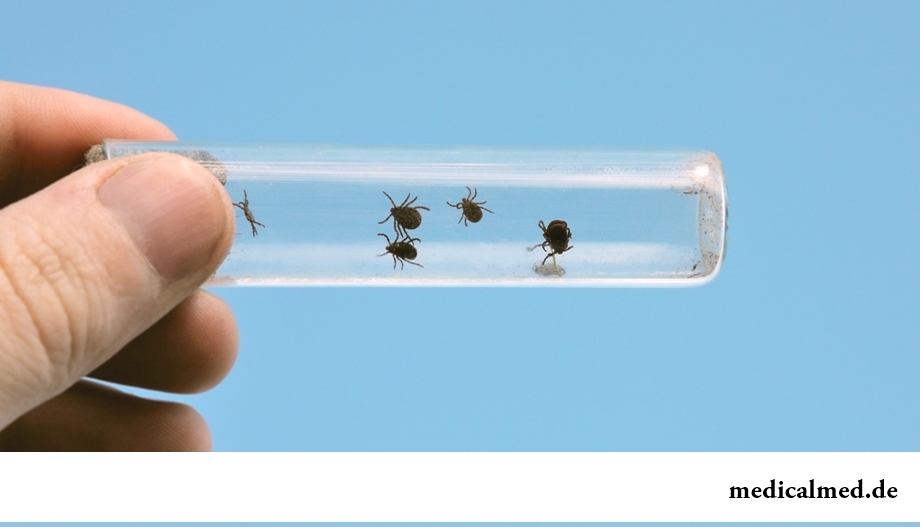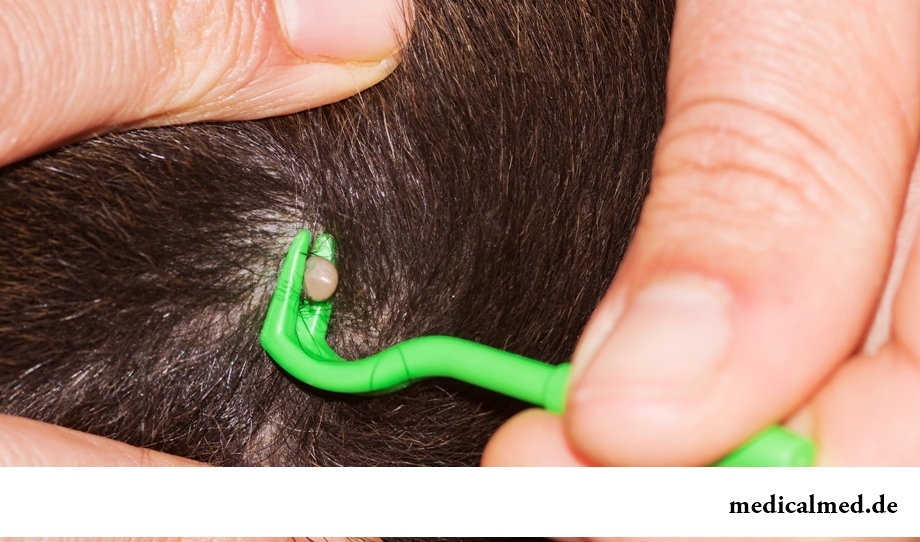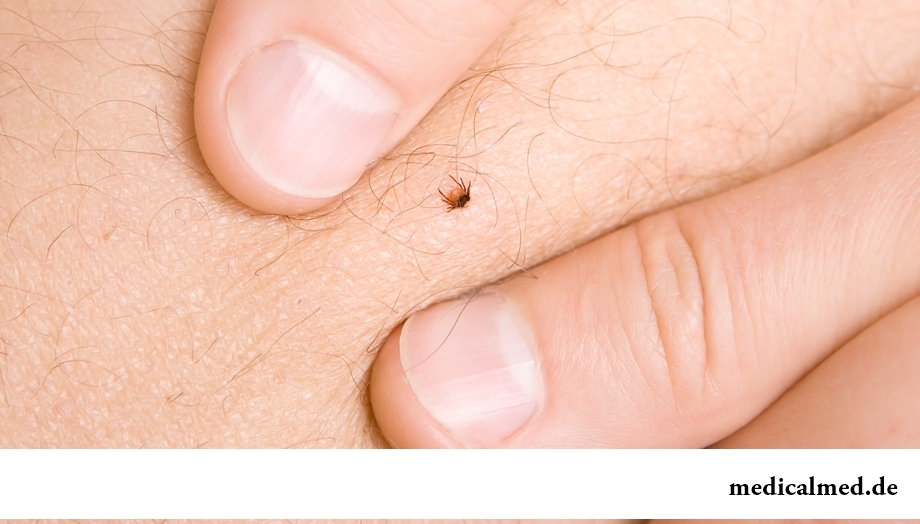





10 myths about mites and encephalitis
Tick-borne encephalitis – one of the most dangerous viral diseases which causative agents transfer and is given to people by ixodic mites. These are the small blood-sicking insects living in the considerable territory of our country. The person bitten by a tick can catch also erlikhiozy, bartonnelezy, babeziozy, mycoplasmosis and Lyme's disease. As well as encephalitis, these illnesses affect the central nervous system, and as specific antiviral therapy does not exist, the forecast is very unfavourable: the probability of lethal outcomes is quite high, and most of the had patients receive serious complications, up to disability. The incidence statistics does not please too. From year to year the number of the people who caught at a sting of mites grows. Partly are the reason of it insufficient awareness of our compatriots on specifics of these illnesses and ways of protection against them. There is a set of delusions about a tick-borne encephalitis and its carriers. Let's get acquainted with the most widespread of them.
1. The virus of encephalitis lives only in mites
Actually, mites only carry a virus. In the nature the activator lives in an organism of birds, rats, wild hoofed animals and a livestock (goats, cows). The tick who bit the infected animal gets a virus which breeds in its sialadens with blood. The person can catch encephalitis and through raw goat or cow's milk.

2. Any tick can infect the person
Such statement is partly right. Only two species of mites transfer dangerous viruses: taiga and forest European and those can be not infected, however the nonspecialist cannot distinguish them from harmless relatives. Therefore any sting of a tick should be considered potentially dangerous.

3. Ticks live on trees
It absolutely not so. Carriers of a virus of encephalitis live preferential in a dense grass, not above a half a meter from the earth so the open field or a meadow in this sense are not less dangerous, than a midwood. As a rule, the tick sits, having hidden, near a footpath and waits any hematothermal animal to hang on him, having hooked for wool. Then the insect creeps on a body of the victim, aiming to find the place, most convenient for a sting.
The delusion arose, apparently, because on a body of the person the tick usually moves from below up, trying to creep in a skin fold or other place with the most gentle, thin cover.

4. Ticks attack people in light clothes more often
Ticks badly see and do not distinguish color. Dark fabric does not protect from them. But cover clothes in which the person walks on the wood, it is very important. The suit has to have skintight cuffs on trousers and sleeves. The most suitable footwear are high boots. Also the headdress or a hood is necessary.

5. The doctor has to pull out the stuck tick
For the person bitten by a tick, the matter of time is vital. The longer the insect remains on skin, the bigger number of activators gets to blood, and the disease course depends on it. Therefore at impossibility to urgently visit the doctor, the tick needs to be pulled out independently.
From this does not follow that the subsequent visit to the doctor can be neglected. The taken-out tick (it is desirable live), it is necessary to show to the specialist to estimate probability of infection. There is also one more statement: having allegedly pulled out a tick within 24 hours, it is possible to secure the person against infection completely. It is incorrect too: even the promptest actions of a guarantee of absence of infection do not give.

6. A tick it is possible to induce to be unhooked, having oiled skin
Probably, means that the insect will have nothing to breathe, and it will weaken a bite to take a sip air. Actually openings through which the tick breathes are at him on an abdomen so this method is absolutely insolvent. Two most effective ways of pulling of the stuck ticks consist in the following:
- Insect tie with a strong thread as it is possible closer to a proboscis (to skin of the person), then stretch the ends of thread, making the shaking movements. If the little body comes off, the got stuck head is taken the needle calcinated on fire;
- In the place of suction of a tick will organize intensive having blown in skin. As a make-shift it is possible to use the big syringe, the syringe or the bicycle pump. The matter is that ticks are extremely picky in sense of the choice of the place of a sting. It is very important for them that it was protected from drafts. Having felt artificially caused wind, the insect begins to worry, weakens a bite and is easily taken by tweezers.
It is dangerous to unscrew a tick fingers: he will seize skin even more strong. If the insect is accidentally crushed, it will increase risk of entering in a wound of an additional infection, besides, it should be taken out a needle in parts.

7. The tick can be implemented under skin and lay eggs
The false statement arose because some confuse ixodic ticks to scabby. The last really are implemented under skin, but carriers of encephalitis use the person and hematothermal animals only as food sources.

8. Repellents protect from mites
The existing antitick-borne means have very low performance. Besides, it is necessary to consider specifics of behavior of an insect: the tick usually seizes clothes (most often in a trouser-leg or a hem of a skirt) or in soft footwear, and repellents apply on open body parts. So use of chemical protective equipment of safety does not guarantee.

9. There are drugs replacing a vaccine
Unfortunately, there are no such drugs today. Besides, administration of immunoglobulins after a sting of a tick in some cases can lead to an aggravation of symptoms of patients.
There are tablets which are also actively propagandized by producers allegedly completely liquidating the virus which got to blood at a sting. According to specialists, they do not provide such action, and unfair advertizing enters buyers into a life-threatening delusion.

10. The encephalitis inoculation is not always effective
Single vaccination protects from an infection only during the next season. To receive durable immunity, it is necessary to pass a revaccination in a year.

The person bitten by a tick gets sick not always. The insect can not be the virus carrier. Sometimes victims have a disease in the latent form which does not have pathological manifestations. The incubation interval of encephalitis makes 7-20 days (at infection through milk – about a week), however meet both fulminant (less than a day), and long (more than 30 days) of a form. Anyway, after walk outdoors it is necessary to examine the body and clothes carefully. In the presence of the stuck tick it is necessary to remove him and as soon as possible to show to the specialist. Emergence in the next days of high temperature, head and muscular pain, drowsiness, nausea, gripes in eyes and other unpleasant symptoms has to become the reason of the urgent address to the doctor.
According to WHO researches the daily half-hour conversation by the mobile phone increases probability of development of a tumor of a brain by 40%.

Life activity of one-celled fungi of the sort Candida is a proximate cause of development of candidiasis (milkwoman), it is related...
Section: Articles about health
It is impossible to imagine human life in which there would be no plants. Practically in each apartment and any production room there are window plants, millions of people with pleasure are engaged in gardening and truck farming, many citizens пр...
Section: Articles about health
The body of the person almost for 60% consists of water. It is so important for normal functioning of an organism that loss of only one and a half percent of liquid already leads to the most unpleasant effects. The problems connected with deficit of water can overtake also the healthiest person if he, for example, spends several hours under the scorching sun, without having taken with themselves drink, but is very simple to correct health in this case. It is much more difficult to minimize effects of other reasons about...
Section: Articles about health
For most of the working people the problem of having a snack is particularly acute enough. Sooner or later there is a question: what is possible quickly for a sja...
Section: Articles about health
An eye of the person daily experiences considerable strain. The problem of preservation of sight is for many years directly connected with a question of supply of tissues of eye enough oxygen and nutrients. This task is carried out by small vessels – capillaries. For holes...
Section: Articles about health
The summer of this year in Russia was very ambiguous. Regions suffered from a merciless heat, from pouring rains, the hail from time to time dropped out, then there was again a heat which alternated with rainfall again. Many people suffer from such sharp changes of weather. Even flu epidemics and a SARS were recorded....
Section: Articles about health
It would seem, about it there can be no disagreements: water is necessary for a human body for normal zhiznedeyatet...
Section: Articles about health
The majority of gynecologic diseases prove three main signs, each of which speaks about need of a visit to the gynecologist. Certainly, it is possible to establish the exact diagnosis only after inspection, but on the basis of some signs it is possible пр...
Section: Articles about health
There is an opinion that at low temperatures safety of products is ensured longer and better thanks to what the refrigerator is considered the most suitable place for storage of food. In most cases it is fair, however there is a number of products for which low temperatures – the main reason of their premature damage. Storage in the refrigerator leads to their bystry rotting, emergence of a mold, is followed by loss of vitamins and tastes. What products it is better to remove...
Section: Articles about health
Healthy lifestyle today in fashion, and many parents think of that the child from the early childhood played sports. To a Torah...
Section: Articles about health
Phobia – the persuasive fear of a certain contents shown in a specific situation against the will of the person. Concepts of a phobia and fear are similar, however if the fear is natural protective function of mentality, then the phobia is its deviation. So the person can an ispytyva...
Section: Articles about health
Statistically, at the address to doctors seven of each ten patients complain of a headache. Actually it is much more people who are periodically feeling unpleasant feelings such. Many people, apart from a headache the reason for serious fears, prefer to muffle independently the next attack medicines. Such behavior is extremely careless, especially if this symptom appears regularly and is followed by other signs of an indisposition. Constants head Bol...
Section: Articles about health
Physical activity is necessary for normal functioning of a human body. At a lack of the movement cease функц...
Section: Articles about health
The words "disease" and "patient" not without reason come from one root – "pain". As a rule, symptoms of illnesses thoroughly spoil to patients life. However from this rule there are exceptions. Some diseases are shown by signs which can cause even полож...
Section: Articles about health
We present to yours the TOP of the medicamentous means exerting the stimulating impact on a potentiality, i.e. on ability of the man to commission of sexual intercourse. At once it is necessary to tell that not always disturbances of erectile function can be eliminated with reception of this or that drug. The reasons of decrease in a potentiality there can be a set, from banal overfatigue before tumoral process in a small basin therefore if the man faces similar problems too often, it should turn...
Section: Articles about health
All like to sing. Small children with pleasure are engaged in a vocal, not especially thinking of hit in a melody. Adults most often...
Section: Articles about health
A little more than a century ago goat milk was a traditional food stuff of most of Russians. Unfortunately, today on tables of our compatriots it appears extremely seldom. The reason that the use of so useful product practically descended on...
Section: Articles about health
Shops of household appliances offer us the huge choice of various devices for the house. Whether there are among this abundance devices which not only facilitate house work, but also help to keep health of the person? Of course, and we will tell about them today....
Section: Articles about health
80% of women at least once to lives complained of discomfortable feelings to breasts, consolidations and nagrubaniye. These are mastopathy symptoms. Mas...
Section: Articles about health
The mankind knows that some toxins at intake in the minimum quantities have therapeutic effect from an extreme antiquity. Many substances recognized poisonous are applied in the medical purposes also today, being the main deystvuyushch...
Section: Articles about health
Tea is loved and use almost everything. This drink has tonic properties, contains the tannins capable to suppress activity of causative organisms. Recently great popularity was gained by teas with vegetable additives. The medicative herbs, spices and fruit which are a part of such mixes enrich drink with vitamins and microelements, increasing its nutritional value and creating additional curative effect....
Section: Articles about health
For anybody not a secret that the modern person eats not as his ancestors. For the last 100 years in broad access appeared with...
Section: Articles about health
The depression not without reason is considered one their main troubles of our century: for scientific and technical progress, acceleration of rate of life and a surplus of information of people it is forced to pay with stresses, negative emotions and weakening of protective forces of an organism. As a result ш...
Section: Articles about health
EKO, or extracorporal fertilization - a method of treatment of infertility which became the reason of a set of broken-down copies in due time accused the people working on its creation neither more nor less of rivalry good luck. Already very few people deny the right of a method for existence, and to surprise nobody with "children from a test tube". And nevertheless, a certain magic in the procedure of artificial fertilization is, process of origin of new life is always a secret, and even it р now...
Section: Articles about health
In consciousness of our many compatriots idea that folk remedies if no more эфф strongly took roots...
Section: Articles about health
Each person supports all life a SARS about 200 times. The peak of incidence falls on cold season, but it is possible to get sick with a temperature and a pharyngalgia, and sometimes and very possibly, even during a heat. The reasons for development of catarrhal diseases exists множество:...
Section: Articles about health
Herpes simplex of the first type (the infectious disease which is shown periodic bubble rashes on lips is called) – one of the most widespread illnesses. Statistically, only 5% of inhabitants of our planet are unreceptive to its activator, and the reasons of this feature are still not found out. Other people are virus carriers....
Section: Articles about health
